IMO及其公约
- 格式:ppt
- 大小:195.00 KB
- 文档页数:34
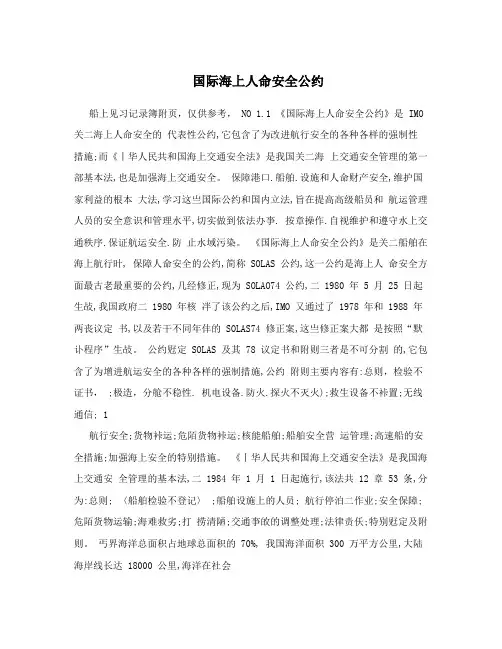
国际海上人命安全公约船上见习记录簿附页,仅供参考, NO 1.1 《国际海上人命安全公约》是 IMO 关二海上人命安全的代表性公约,它包含了为改进航行安全的各种各样的强制性措施;而《丨华人民共和国海上交通安全法》是我国关二海上交通安全管理的第一部基本法,也是加强海上交通安全。
保障港口.船舶.设施和人命财产安全,维护国家利益的根本大法,学习这亗国际公约和国内立法,旨在提高高级船员和航运管理人员的安全意识和管理水平,切实做到依法办亊. 按章操作.自视维护和遵守水上交通秩序.保证航运安全.防止水域污染。
《国际海上人命安全公约》是关二船舶在海上航行旪, 保障人命安全的公约,简称 SOLAS 公约,这一公约是海上人命安全方面最古老最重要的公约,几经修正,现为 SOLAO74 公约,二 1980 年 5 月 25 日起生敁,我国政府二 1980 年核冸了该公约之后,IMO 又通过了 1978 年和 1988 年两丧议定书,以及若干不同年仹的 SOLAS74 修正案,这亗修正案大都是按照“默讣程序”生敁。
公约觃定 SOLAS 及其 78 议定书和附则三者是不可分割的,它包含了为增进航运安全的各种各样的强制措施,公约附则主要内容有:总则,检验不证书, ;极造,分舱不稳性. 机电设备.防火.探火不灭火);救生设备不裃置;无线通信; 1航行安全;货物裃运;危陌货物裃运;核能船舶;船舶安全营运管理;高速船的安全措施;加强海上安全的特别措施。
《丨华人民共和国海上交通安全法》是我国海上交通安全管理的基本法,二 1984 年 1 月 1 日起施行,该法共 12 章 53 条,分为:总则; 〈船舶检验不登记〉 ;船舶设施上的人员; 航行停泊二作业;安全保障;危陌货物运输;海难救劣;打捞清陋;交通亊敀的调整处理;法律责仸;特别觃定及附则。
丐界海洋总面积占地球总面积的 70%, 我国海洋面积 300 万平方公里,大陆海岸线长达 18000 公里,海洋在社会发展和经浌建设丨占有非常重要地位,海洋环境也是人类赖以生存和发展的物资基础,海洋不仅是天然宝库,也是天然的交通大道 ;为大量运输物资和人员提供最廉价的方法,海上运输是丐界各国人民经浌.文化交流的重要手殌,随着工业技术的发展以及人口飞速的增长,海上货运量逐年大幅度增长,丐界船舶总吨位和尺度也不断增加,船舶在通常的营运过程丨不可避免地直接戒间接把一亗物质戒能量引入海洋环境,以至二产生损害生物资源,危及人类健康,妨碍包括渔业活劢在内的各种海洋活劢,破坏海水的使用素质和舒适程度的有害影响,及造成海洋污染。
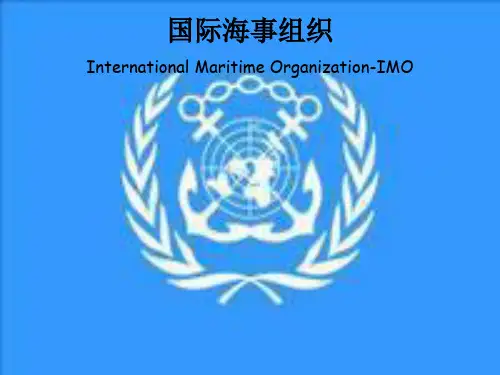
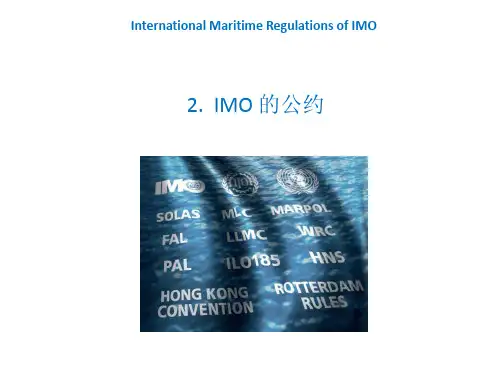
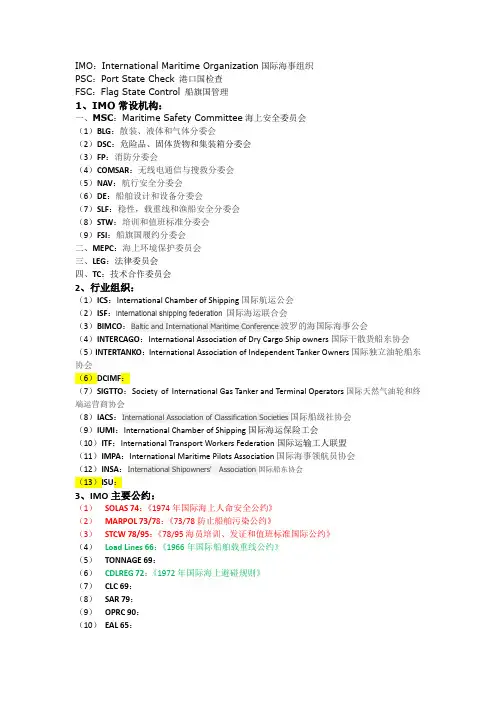
IMO:International Maritime Organization国际海事组织PSC:Port State Check 港口国检查FSC:Flag State Control 船旗国管理1、IMO常设机构:一、MSC:Maritime Safety Committee海上安全委员会(1)BLG:散装、液体和气体分委会(2)DSC:危险品、固体货物和集装箱分委会(3)FP:消防分委会(4)COMSAR:无线电通信与搜救分委会(5)NAV:航行安全分委会(6)DE:船舶设计和设备分委会(7)SLF:稳性,载重线和渔船安全分委会(8)STW:培训和值班标准分委会(9)FSI:船旗国履约分委会二、MEPC:海上环境保护委员会三、LEG:法律委员会四、TC:技术合作委员会2、行业组织:(1)ICS:International Chamber of Shipping国际航运公会(2)ISF:international shipping federation 国际海运联合会(3)BIMCO:Baltic and International Maritime Conference波罗的海国际海事公会(4)INTERCAGO:International Association of Dry Cargo Ship owners国际干散货船东协会(5)INTERTANKO:International Association of Independent Tanker Owners 国际独立油轮船东协会(6)DCIMF:(7)SIGTTO:Society of International Gas Tanker and Terminal Operators国际天然气油轮和终端运营商协会(8)IACS:International Association of Classification Societies国际船级社协会(9)IUMI:International Chamber of Shipping国际海运保险工会(10)ITF:International Transport Workers Federation国际运输工人联盟(11)IMPA:International Maritime Pilots Association 国际海事领航员协会(12)INSA:International Shipowners' Association国际船东协会(13)ISU:3、IMO主要公约:(1)SOLAS 74:《1974年国际海上人命安全公约》(2)MARPOL 73/78:《73/78防止船舶污染公约》(3)STCW 78/95:《78/95海员培训、发证和值班标准国际公约》(4)Load Lines 66:《1966年国际船舶载重线公约》(5)TONNAGE 69:(6)CDLREG 72:《1972年国际海上避碰规则》(7)CLC 69:(8)SAR 79:(9)OPRC 90:(10)EAL 65:。
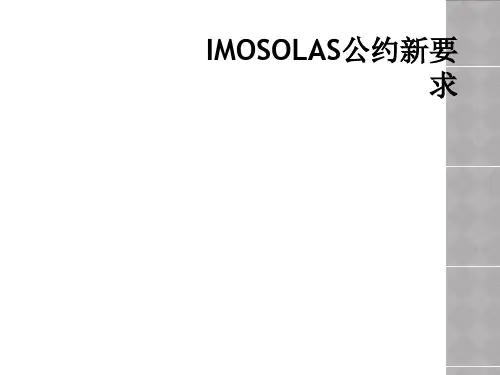
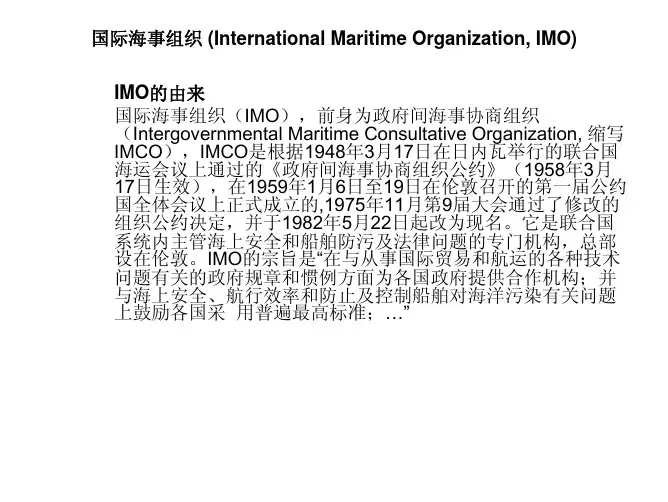
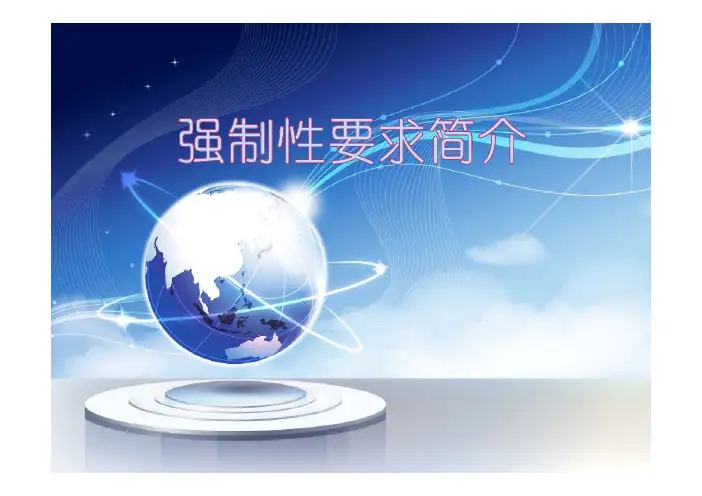
z1. 2.本教材主要涉及公约、规范、规则等强制性 要求的简介 通过对本科目的学习 希望各 要求的简介,通过对本科目的学习,希望各 位掌握以下方面的具体内容: 强制性要求的整体框架; 如何快速的查询适用的公约、规范等要求。
z强制性要求体系简介国际公约 国家法律、法规 入级规范 公司体系zzIMO相关要求国际海事组织 (International Maritime Organization -- IMO) ) 是联合国负责海上航行安全和防止船舶造成海 洋污染的 个专门机构 总部设在伦敦 洋污染的一个专门机构,总部设在伦敦。
最早成立于1959年1月6日,原名“政府间海事协商 组织”,1982年5月改为现名,现有 组织 年5月改为现名 现有170个正式成员和 3个联系会员(至2012年09月)。
该组织宗旨为促进各国间的航运技术合作,鼓励各国 在促进海上安全 提高船舶航行效率 防止和控制船 在促进海上安全,提高船舶航行效率,防止和控制船 舶对海洋污染方面采取统一的标准,处理有关的法律 问题 问题。
zzzIMO的组织机构由大会、理事会、五个专门委员 的 机构由大会 事会 个专 会和秘书处组成。
z大会是IMO的最高管理机构,它由所有成员国组 的最高管理机构 它由所有成员国组 成。
每两年举行一次会议。
但如果需要,在非常时 期也会举行 大会负责批准工作程序 对组织的预 期也会举行。
大会负责批准工作程序,对组织的预 算和财政安排进行表决,以及选举理事会。
z理事会由大会选出,任期两年。
理事会是大会的 执行机构。
zIMO设五个专门委员会,分别为:海上安全委员 会、法律委员会、海上环境保护委员会、技术合作 委员会和便利运输委员会。
z五个委员会中最重要的是海上安全委员会及海上环境 保护委员会。
海上安全委员会(简称海安会)是最早 设立的一个主要委员会 也是组织的最高技术机构 设立的一个主要委员会,也是组织的最高技术机构, 由所有成员国组成。
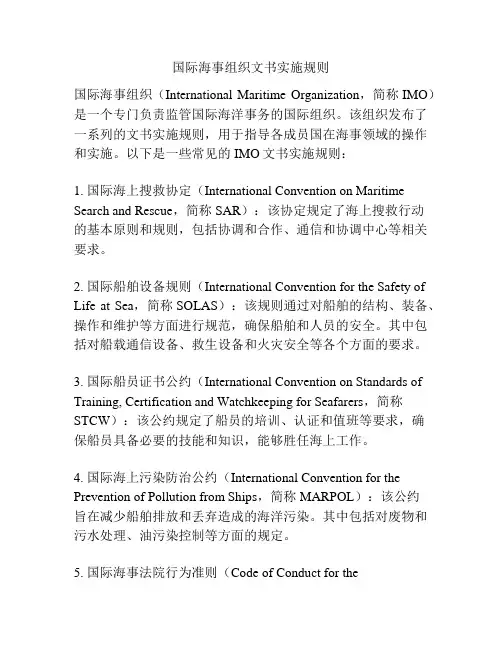
国际海事组织文书实施规则国际海事组织(International Maritime Organization,简称IMO)是一个专门负责监管国际海洋事务的国际组织。
该组织发布了一系列的文书实施规则,用于指导各成员国在海事领域的操作和实施。
以下是一些常见的IMO文书实施规则:1. 国际海上搜救协定(International Convention on Maritime Search and Rescue,简称SAR):该协定规定了海上搜救行动的基本原则和规则,包括协调和合作、通信和协调中心等相关要求。
2. 国际船舶设备规则(International Convention for the Safety of Life at Sea,简称SOLAS):该规则通过对船舶的结构、装备、操作和维护等方面进行规范,确保船舶和人员的安全。
其中包括对船载通信设备、救生设备和火灾安全等各个方面的要求。
3. 国际船员证书公约(International Convention on Standards of Training, Certification and Watchkeeping for Seafarers,简称STCW):该公约规定了船员的培训、认证和值班等要求,确保船员具备必要的技能和知识,能够胜任海上工作。
4. 国际海上污染防治公约(International Convention for the Prevention of Pollution from Ships,简称MARPOL):该公约旨在减少船舶排放和丢弃造成的海洋污染。
其中包括对废物和污水处理、油污染控制等方面的规定。
5. 国际海事法院行为准则(Code of Conduct for theInternational Maritime Organization and for the Members of its Organs,简称Code of Conduct):该准则规定了IMO及其组织成员的行为规范,包括职业道德、利益冲突、行为守则等方面的内容。
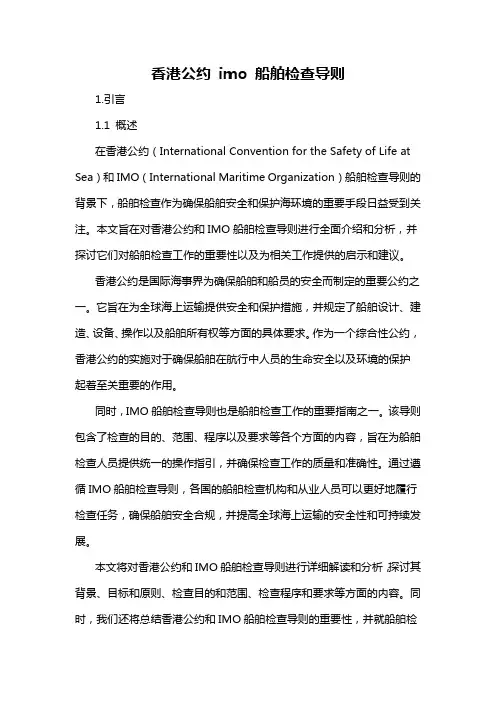
香港公约imo 船舶检查导则1.引言1.1 概述在香港公约(International Convention for the Safety of Life at Sea)和IMO(International Maritime Organization)船舶检查导则的背景下,船舶检查作为确保船舶安全和保护海环境的重要手段日益受到关注。
本文旨在对香港公约和IMO船舶检查导则进行全面介绍和分析,并探讨它们对船舶检查工作的重要性以及为相关工作提供的启示和建议。
香港公约是国际海事界为确保船舶和船员的安全而制定的重要公约之一。
它旨在为全球海上运输提供安全和保护措施,并规定了船舶设计、建造、设备、操作以及船舶所有权等方面的具体要求。
作为一个综合性公约,香港公约的实施对于确保船舶在航行中人员的生命安全以及环境的保护起着至关重要的作用。
同时,IMO船舶检查导则也是船舶检查工作的重要指南之一。
该导则包含了检查的目的、范围、程序以及要求等各个方面的内容,旨在为船舶检查人员提供统一的操作指引,并确保检查工作的质量和准确性。
通过遵循IMO船舶检查导则,各国的船舶检查机构和从业人员可以更好地履行检查任务,确保船舶安全合规,并提高全球海上运输的安全性和可持续发展。
本文将对香港公约和IMO船舶检查导则进行详细解读和分析,探讨其背景、目标和原则、检查目的和范围、检查程序和要求等方面的内容。
同时,我们还将总结香港公约和IMO船舶检查导则的重要性,并就船舶检查工作提出相关的启示和建议,以促进航运行业的健康发展和海洋环境的保护。
在后续的章节中,我们将从不同的角度对香港公约和IMO船舶检查导则进行深入探讨,希望读者能够通过本文深入了解这两个重要的航运标准和指南,为船舶检查工作的开展提供有益的参考和指导。
文章结构部分的内容如下:1.2 文章结构本文主要分为三个部分: 引言、正文和结论。
引言部分介绍了本文的概述、文章结构和目的。
首先会对香港公约和IMO船舶检查导则进行简要的概述,以便读者对主题有一个整体的了解。
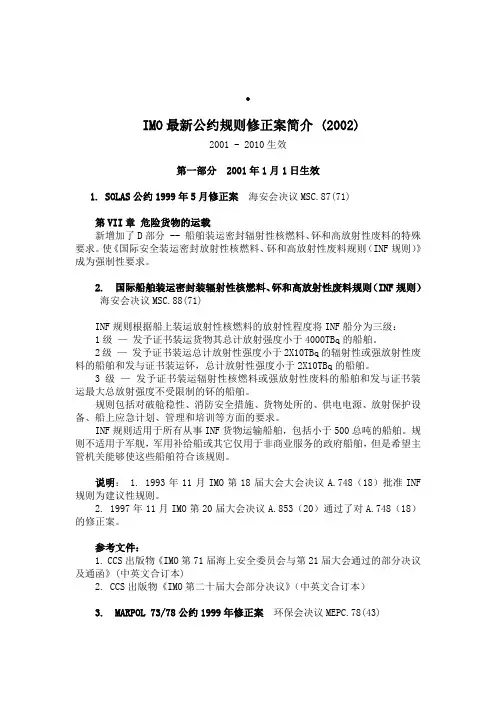
·IMO最新公约规则修正案简介 (2002)2001 - 2010生效第一部分 2001年1月1日生效1. SOLAS公约1999年5月修正案海安会决议MSC.87(71)第VII章危险货物的运载新增加了D部分 -- 船舶装运密封辐射性核燃料、钚和高放射性废料的特殊要求。
使《国际安全装运密封放射性核燃料、钚和高放射性废料规则(INF规则)》成为强制性要求。
2. 国际船舶装运密封装辐射性核燃料、钚和高放射性废料规则(INF规则)海安会决议MSC.88(71)INF规则根据船上装运放射性核燃料的放射性程度将INF船分为三级:1级—发予证书装运货物其总计放射强度小于4000TBq的船舶。
2级—发予证书装运总计放射性强度小于2X10TBq的辐射性或强放射性废料的船舶和发与证书装运钚,总计放射性强度小于2X10TBq的船舶。
3级—发予证书装运辐射性核燃料或强放射性废料的船舶和发与证书装运最大总放射强度不受限制的钚的船舶。
规则包括对破舱稳性、消防安全措施、货物处所的、供电电源、放射保护设备、船上应急计划、管理和培训等方面的要求。
INF规则适用于所有从事INF货物运输船舶,包括小于500总吨的船舶。
规则不适用于军舰,军用补给船或其它仅用于非商业服务的政府船舶,但是希望主管机关能够使这些船舶符合该规则。
说明: 1. 1993年11月IMO第18届大会大会决议A.748(18)批准INF 规则为建议性规则。
2. 1997年11月IMO第20届大会决议A.853(20)通过了对A.748(18)的修正案。
参考文件:1. CCS出版物《IMO第71届海上安全委员会与第21届大会通过的部分决议及通函》(中英文合订本)2. CCS出版物《IMO第二十届大会部分决议》(中英文合订本)3. MARPOL 73/78公约1999年修正案环保会决议MEPC.78(43)附则I第13条防止现有油船油污染的措施附则I第13条防止现有油船油污染措施的修正案将本条规则原适用于20,000载重吨以上原油油船和30,000载重吨以上成品油油船的范围扩大到20,000载重吨以上装运燃油、重柴油或滑油的油船。
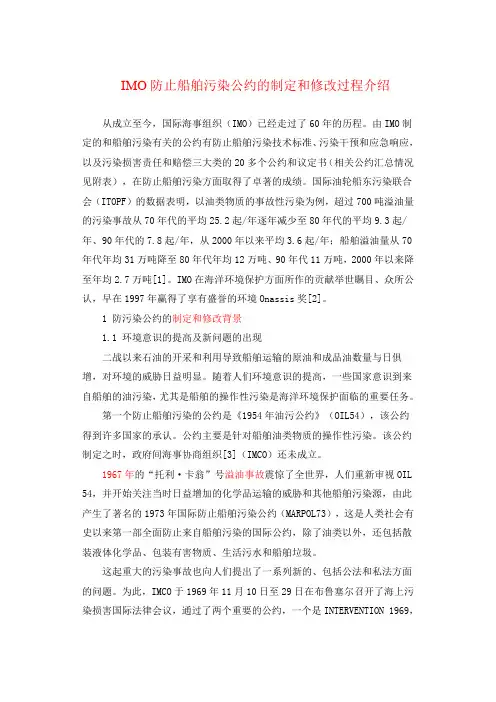
IMO防止船舶污染公约的制定和修改过程介绍从成立至今,国际海事组织(IMO)已经走过了60年的历程。
由IMO制定的和船舶污染有关的公约有防止船舶污染技术标准、污染干预和应急响应,以及污染损害责任和赔偿三大类的20多个公约和议定书(相关公约汇总情况见附表),在防止船舶污染方面取得了卓著的成绩。
国际油轮船东污染联合会(ITOPF)的数据表明,以油类物质的事故性污染为例,超过700吨溢油量的污染事故从70年代的平均25.2起/年逐年减少至80年代的平均9.3起/年、90年代的7.8起/年,从2000年以来平均3.6起/年;船舶溢油量从70年代年均31万吨降至80年代年均12万吨、90年代11万吨,2000年以来降至年均2.7万吨[1]。
IMO在海洋环境保护方面所作的贡献举世瞩目、众所公认,早在1997年赢得了享有盛誉的环境Onassis奖[2]。
1 防污染公约的制定和修改背景1.1 环境意识的提高及新问题的出现二战以来石油的开采和利用导致船舶运输的原油和成品油数量与日俱增,对环境的威胁日益明显。
随着人们环境意识的提高,一些国家意识到来自船舶的油污染,尤其是船舶的操作性污染是海洋环境保护面临的重要任务。
第一个防止船舶污染的公约是《1954年油污公约》(OIL54),该公约得到许多国家的承认。
公约主要是针对船舶油类物质的操作性污染。
该公约制定之时,政府间海事协商组织[3](IMCO)还未成立。
1967年的“托利·卡翁”号溢油事故震惊了全世界,人们重新审视OIL 54,并开始关注当时日益增加的化学品运输的威胁和其他船舶污染源,由此产生了著名的1973年国际防止船舶污染公约(MARPOL73),这是人类社会有史以来第一部全面防止来自船舶污染的国际公约,除了油类以外,还包括散装液体化学品、包装有害物质、生活污水和船舶垃圾。
这起重大的污染事故也向人们提出了一系列新的、包括公法和私法方面的问题。
为此,IMCO于1969年11月10日至29日在布鲁塞尔召开了海上污染损害国际法律会议,通过了两个重要的公约,一个是INTERVENTION 1969,该公约在国际公法领域是一个很大的突破,给予沿海国政府干预的权利。
IMO #10 - 船舶再循环公约 2009.10.15船舶再循环公约鉴于世界船队的老化和单壳 VLCC 的退伍在未来的几年中将有大批的旧船被解体.IMO 于2007年开始便着手起草一份可以确保拆船厂工人的安全和对拆船地环保的公约并希这份草稿在2009年MEPC于香港开会时可以通过.IMO海上环保组织 (MEPC) 今年5月依期在香港举行会议并立案一条叫:International Convention for the Safe & Environmentally Sound Recycling的公约. 5月11日到15日的会议共有63个国家参加. 公约内容大约如下:1. 船舶的设计, 建造, 营运和解体时的安全和环保必需更新.2. 船舶必需举行初期船上危险物件的检验. 然后于解体前作一次最后检查.3. 拆船厂必需根据船的结构提供具体方案,解释进行步骤.这个新公约将影响到新船的设计和建造成本. 该公约内容和背景的英文版本如下 :Recycling of shipsThe Hong Kong International Convention for the Safe and Environmentally Sound Recycling of Ships, 2009, was adopted in May 2009.It is aimed at ensuring that ships, when being recycled after reaching the end of their operational lives, do not pose any unnecessary risk to human health and safety or to the environment.The Convention was adopted at a diplomatic conference held in Hong Kong, China, from 11 to 15 May 2009, attended by delegates from 63 countries.The new Convention intends to address all the issues around ship recycling, including the fact that ships sold for scrapping may contain environmentally hazardous substances such as asbestos, heavy metals, hydrocarbons, ozone-depleting substances and others. It will address concerns raised about the working and environmental conditions at many of the world's ship recycling locations.The text of the ship recycling Convention has been developed over the past three years, with input from IMO Member States and relevant non-governmental organizations, and inco-operation with the International Labour Organization and the Parties to the Basel Convention.Regulations in the new Convention cover: the design, construction, operation and preparation of ships so as to facilitate safe and environmentally sound recycling, without compromising the safety and operational efficiency of ships; the operation of ship recycling facilities in a safe and environmentally sound manner; and the establishment of an appropriate enforcement mechanism for ship recycling, incorporating certification and reporting requirements.Ships to be sent for recycling will be required to carry an inventory of hazardous materials, which will be specific to each ship. An appendix to the Convention will provide a list of hazardous materials the installation or use of which is prohibited or restricted in shipyards, ship repair yards, and ships of Parties to the Convention. Ships will be required to have an initial survey to verify the inventory of hazardous materials, additional surveys during the life of the ship, and a final survey prior to recycling.Ship recycling yards will be required to provide a "Ship Recycling Plan", to specify the manner in which each ship will be recycled, depending on its particulars and its inventory. Parties will be required to take effective measures to ensure that ship recycling facilities under their jurisdiction comply with the Convention.A series of guidelines are being developed to assist in the Convention's implementation.Entry into force criteriaThe Convention shall be open for signature by any State at the Headquarters of the Organization from 1 September 2009 to 31 August 2010 and shall thereafter remain open for accession by any State. It will enter into force 24 months after the date on which 15 States, representing 40 per cent of world merchant shipping by gross tonnage, have either signed it without reservation as to ratification, acceptance or approval or have deposited instruments of ratification, acceptance, approval or accession with the Secretary General.Furthermore, the combined maximum annual ship recycling volume of those States must, during the preceding 10 years, constitute not less than 3 per cent of their combined merchant shipping tonnage.Resolutions adopted by the conferenceThe conference also adopted six resolutions as follows:Resolution 1:Expression of appreciation to the host Government;Resolution 2:Contribution of the Parties to the Basel Convention and theInternational Labour Organization in the development of theHong Kong International Convention for the Safe andEnvironmentally Sound Recycling of Ships, 2009;Resolution 3:Promotion of technical co-operation and assistance;Resolution 4:Future work by the Organization pertaining to the Hong KongInternational Convention for the Safe and EnvironmentallySound Recycling of Ships, 2009;Resolution 5:Early implementation of the technical standards of the HongKong International Convention for the Safe and EnvironmentallySound Recycling of Ships, 2009; andResolution 6:Exploration and monitoring of the best practices for fulfilling therequirements of the Hong Kong International Convention for theSafe and Environmentally Sound Recycling of Ships, 2009.BackgroundIMO adopted Guidelines on Ship Recycling at the 23rd Assembly in November-December 2003.At its 53rd session in July 2005, the Marine Environment Protection Committee (MEPC) agreed that the IMO should develop, as a high priority, a new instrument on recycling of ships with a view to providing legally binding and globally applicable ship recycling regulations for international shipping and for recycling facilities. MEPC 53 also agreed that the new IMO instrument on ship recycling should include regulations for the design, construction, operation and preparation of ships so as to facilitate safe and environmentally sound recycling, without compromising the safety and operational efficiency of ships; the operation of ship recycling facilities in a safe and environmentally sound manner; and the establishment of an appropriate enforcement mechanism for ship recycling(certification/reporting requirements). MEPC 53 further agreed that the above-mentioned instrument should be completed in time for its consideration and adoption in the biennium 2008-2009.The IMO Assembly in November-December 2005 subsequently agreed that IMO should develop a new legally-binding instrument on ship recycling. The Assembly resolutionA.981(24) New legally-binding instrument on Ship Recycling requests the Marine Environment Protection Committee to develop a new instrument that would provide regulations for:-the design, construction, operation and preparation of ships so as to facilitate safe and environmentally sound recycling, without compromising the safety and operational efficiency of ships;-the operation of ship recycling facilities in a safe and environmentally sound manner;and-the establishment of an appropriate enforcement mechanism for ship recycling,incorporating certification and reporting requirements.The aim is to complete the instrument in time for its consideration and adoption in the 2008-2009 biennium. The resolution refers to the urgent need for IMO to contribute to the development of an effective solution to the issue of ship recycling, which will minimize, in the most effective, efficient and sustainable way, the environmental, occupational health andsafety risks related to ship recycling, taking into account the particular characteristics of world maritime transport and the need for securing the smooth withdrawal of ships that have reached the end of their operating lives.The Assembly also adopted amendments to the existing Guidelines on Ship Recycling, relating to the inventory of potentially hazardous materials present in a ship's structure and equipment and the Green Passport for ships.MEPC 55 outcomeAt the Marine Environment Protection Committee (MEPC) at its 55th session in October 2006, the MEPC Working Group on Ship Recycling further developed the text of the draft Convention providing globally applicable ship recycling regulations for international shipping and for recycling activities and it agreed to request the IMO Council, at its 98th session (in June 2007), to consider the allocation of a five-day international conference in the 2008-2009 biennium to adopt it.It is intended that the Convention will provide regulations for:•the design, construction, operation and preparation of ships so as to facilitate safe and environmentally sound recycling, without compromising the safety and operational efficiency of ships;•the operation of ship recycling facilities in a safe and environmentally sound manner;and•the establishment of an appropriate enforcement mechanism for ship recycling,incorporating certification and reporting requirements.A correspondence group was established to continue developing the draft convention and related guidelines and it was agreed to hold an intersessional meeting of the Ship Recycling Working Group, ahead of the next MEPC session scheduled for July 2007.。
solas公约各部分主要内容
Solas公约是国际海事组织(IMO)制定的一项国际公约,旨在确保国际海上安全,并规定了船舶的最低安全要求。
Solas 公约分为13个主要部分,主要内容如下:
1.第一部分 - 一般规则:规定了适用于整个公约的定义和一般规则。
2.第二部分 - 构造要求:规定了船舶的结构规格和船体设计要求,以确保其结构强度和稳定性。
3.第三部分 - 配备和设备:规定了船舶必须配备的各种设备和器材,包括通信设备、导航设备、灭火设备等。
4.第四部分 - 灭火规定:规定了防火和灭火系统的要求,包括火灾报警系统、灭火设备等。
5.第五部分 - 救生设备和安全安排:规定了船舶必须配备的各种救生设备和安全安排,包括救生艇、救生筏等。
6.第六部分 - 载运规定:涉及货物的装载和运输规定,包括货物包装、货物分配等。
7.第七部分 - 船舶警报和船员应答:规定了船舶警报系统和船员应对紧急情况的要求。
8.第八部分 - 航行信息:规定了必须向航行中的船舶提供的航
行信息和警告。
9.第九部分 - 船舶运输证书:规定了船舶必须携带的各种证书和文件。
10.第十部分 - 船员证书和船员培训:规定了船员必须具备的证书和培训要求。
11.第十一部分 - 船舶管制:规定了船舶运营和管理的要求,包括船舶检验和审查等。
12.第十二部分 - 灭火器材:规定了船舶必须携带的灭火器材和其使用要求。
13.第十三部分 - 航行员救助:规定了对遇险船舶和船员进行救助的要求和程序。
这些部分共同确保了船舶的安全性、适航性和危险货物的安全运输。